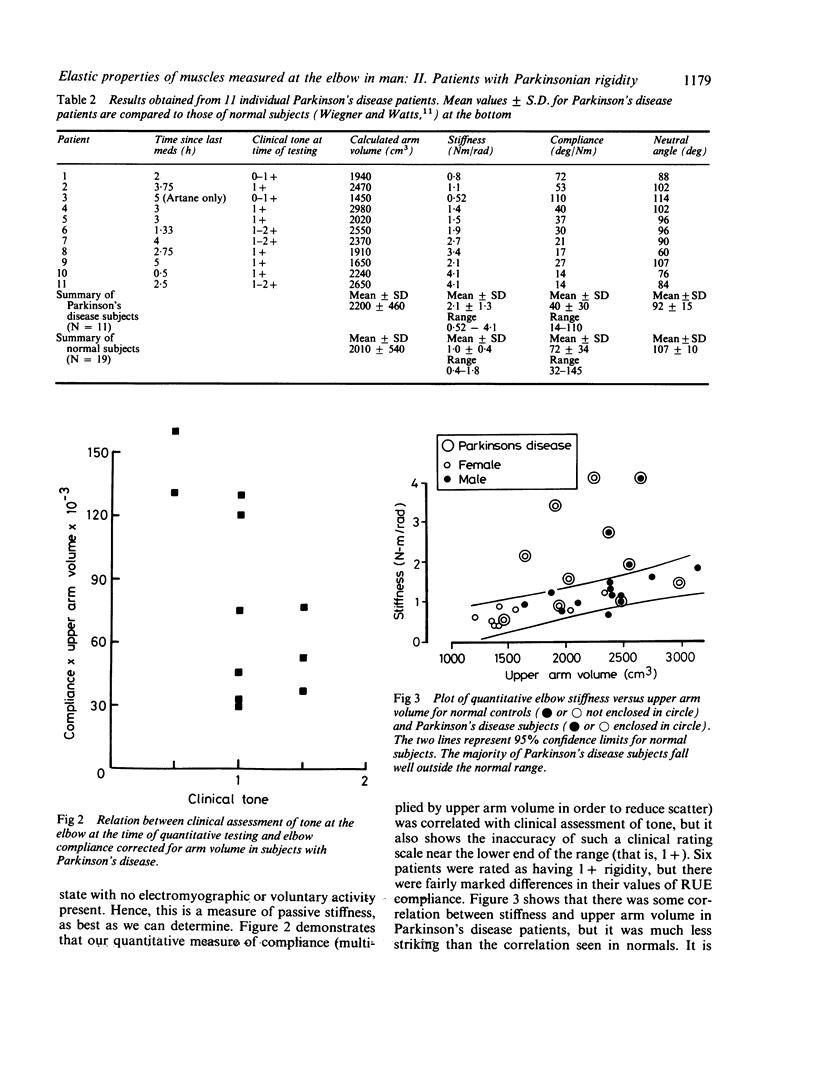Abstract
A method is described to measure reproducibly stiffness, and therefore "tone", at the elbow of patients with Parkinson's disease using a torque motor. In Parkinsonian versus normal patients (previously reported) it was observed that: the neutral angle in Parkinson's disease patients was significantly smaller (92 degrees +/- 15 degrees) than in normals (107 degrees +/- 10 degrees), and in Parkinson's disease patients, even with relatively mild symptoms, the upper limb was stiffer than normals in the totally relaxed state with no electromyographic activity present. Our results suggest that changes in the passive mechanical properties of the upper limb affected by Parkinsonian rigidity may have taken place, accounting for the more flexed neutral elbow angle and greater passive stiffness. Using this technique, response to antirigidity therapy and natural progression of illness can be quantitatively assessed and followed.
Full text
PDF




Selected References
These references are in PubMed. This may not be the complete list of references from this article.
- Andrews C. J., Burke D., Lance J. W. The response to muscle stretch and shortening in Parkinsonian rigidity. Brain. 1972;95(4):795–812. doi: 10.1093/brain/95.4.795. [DOI] [PubMed] [Google Scholar]
- Berger W., Horstmann G., Dietz V. Tension development and muscle activation in the leg during gait in spastic hemiparesis: independence of muscle hypertonia and exaggerated stretch reflexes. J Neurol Neurosurg Psychiatry. 1984 Sep;47(9):1029–1033. doi: 10.1136/jnnp.47.9.1029. [DOI] [PMC free article] [PubMed] [Google Scholar]
- Bizzi E., Accornero N., Chapple W., Hogan N. Arm trajectory formation in monkeys. Exp Brain Res. 1982;46(1):139–143. doi: 10.1007/BF00238107. [DOI] [PubMed] [Google Scholar]
- Dietz V., Berger W. Normal and impaired regulation of muscle stiffness in gait: a new hypothesis about muscle hypertonia. Exp Neurol. 1983 Mar;79(3):680–687. doi: 10.1016/0014-4886(83)90032-8. [DOI] [PubMed] [Google Scholar]
- Dietz V., Quintern J., Berger W. Electrophysiological studies of gait in spasticity and rigidity. Evidence that altered mechanical properties of muscle contribute to hypertonia. Brain. 1981 Sep;104(3):431–449. doi: 10.1093/brain/104.3.431. [DOI] [PubMed] [Google Scholar]
- Duggan T. C., McLellan D. L. Technical contribution. Measurement of muscle tone: a method suitable for clinical use. Electroencephalogr Clin Neurophysiol. 1973 Dec;35(6):654–658. doi: 10.1016/0013-4694(73)90220-4. [DOI] [PubMed] [Google Scholar]
- Hayes K. C., Hatze H. Passive visco-elastic properties of the structures spanning the human elbow joint. Eur J Appl Physiol Occup Physiol. 1977 Dec 22;37(4):265–274. doi: 10.1007/BF00430956. [DOI] [PubMed] [Google Scholar]
- Hoehn M. M., Yahr M. D. Parkinsonism: onset, progression and mortality. Neurology. 1967 May;17(5):427–442. doi: 10.1212/wnl.17.5.427. [DOI] [PubMed] [Google Scholar]
- Lakie M., Walsh E. G., Wright G. W. Resonance at the wrist demonstrated by the use of a torque motor: an instrumental analysis of muscle tone in man. J Physiol. 1984 Aug;353:265–285. doi: 10.1113/jphysiol.1984.sp015335. [DOI] [PMC free article] [PubMed] [Google Scholar]
- Landau W. M., Struppler A., Mehls O. A comparative electromyographic study of the reactions to passive movement in parkinsonism and in normal subjects. Neurology. 1966 Jan;16(1):34–48. doi: 10.1212/wnl.16.1.34. [DOI] [PubMed] [Google Scholar]
- Mortimer J. A., Webster D. D. Evidence for a quantitative association between EMG stretch responses and Parkinsonian rigidity. Brain Res. 1979 Feb 16;162(1):169–173. doi: 10.1016/0006-8993(79)90768-6. [DOI] [PubMed] [Google Scholar]
- Nashold B. S., Jr An electronic method of measuring and recording resistance to passive muscle stretch. J Neurosurg. 1966 Jan;24(1 Suppl):310–314. [PubMed] [Google Scholar]
- RUSHWORTH G. Spasticity and rigidity: an experimental study and review. J Neurol Neurosurg Psychiatry. 1960 May;23:99–118. doi: 10.1136/jnnp.23.2.99. [DOI] [PMC free article] [PubMed] [Google Scholar]
- RUSHWORTH G. The gamma system in parkinsonism. Int J Neurol. 1961;2:34–50. [PubMed] [Google Scholar]


